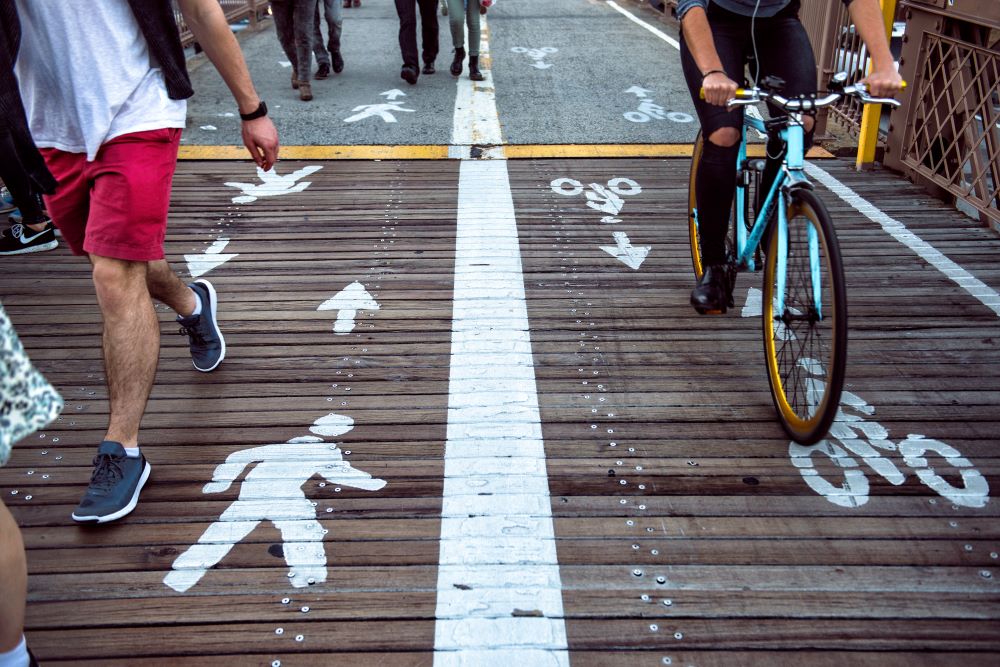Motor vehicles are not the only threats to the safety of bicyclists and pedestrians. Cyclists and pedestrians can each pose a danger to the other. Pedestrian accidents involving cyclists can result in painful injuries for pedestrians and bicyclists alike. Fortunately, right-of-way laws serve to help prevent these accidents in Florida.
Right-of-way laws are useful in controlling the safe flow of wheeled traffic at intersections and other busy junctions. The usefulness of these laws does not disappear simply because the individuals involved are not motorized or have four wheels.
However, unlike the right-of-way laws applicable to car and truck drivers, those that bicyclists and pedestrians must follow when encountering one another are often not as well known.
General Florida Right-of-Way Laws
Right-of-way laws dictate who is able to proceed along their way and when on the road. These rules extend to pedestrians and cyclists, as well as motor vehicles. It is important to note that such rules apply only on public roads and paths, not to activities that take place solely on private property.
Moreover, these right-of-way rules only come into play when two or more applicable individuals meet one another and cannot proceed along their separate ways simultaneously.
When and where they do apply, right-of-way laws tell all involved parties who can proceed along their way and who must wait for the path ahead to be clear. The person who is able to continue their travel is said to have the right-of-way, while all others who must wait before proceeding are described as yielding the right-of-way.
Bicyclists’ Unique Responsibilities on the Road
When it comes to whether bicyclists have the right-of-way over pedestrians, it must first be acknowledged that bicyclists and pedestrians are not subject to the same responsibilities under Florida law.
While there are laws that apply to pedestrians, these laws are unique to pedestrians. Generally, there is no situation where a law that applies to a pedestrian will apply to any wheeled vehicle driver.
This is not the case with bicyclists. For bike riders, Florida Statutes Section 316.2065 says that when bicyclists are using the roadways, they must follow the same rules and laws as drivers of motor vehicles. This includes following the state’s right-of-way laws as they would apply to a motor vehicle in the same situation.
When Pedestrians Have the Right-of-Way Over Cyclists
The classic assumption, “Pedestrians always have the right-of-way,” is not legally true. Pedestrians who believe and act upon this incorrect advice raise the risk of pedestrian accidents. Instead, there are two main situations in which a pedestrian has the right-of-way over other traffic on the road:
Pedestrians in a Controlled Crosswalk
A pedestrian using a crosswalk to get from one side of the road to the other has the right-of-way over all other traffic while in the crosswalk if they follow a control device’s directions. This means that bicyclists using the road must stop and wait until a pedestrian clears the crosswalk before they can proceed.
Pedestrians in an Uncontrolled Crosswalk
If there is no marked crosswalk or an electronic signal does not control the crosswalk, pedestrians still have the right-of-way while they are at the road crossing. Since bicyclists are subject to the same laws and rules as other motorists, they must stop and wait for pedestrians crossing the street to finish before continuing.
These rules apply whether the bicyclist is using a designated bike lane or whether no bike lane is present.
When a Cyclist Encounters a Pedestrian on a Sidewalk
Right-of-way laws apply not only to roadways; they also encompass pathways and sidewalks.
Pedestrians and bicyclists sometimes encounter one another on sidewalks since both are authorized to use them. In this situation, pedestrians always have the right-of-way on a sidewalk, and bicyclists must always yield to a pedestrian using the same sidewalk.
Turn to a Skilled Pedestrian Accidents Lawyer Today
Determining right-of-way is also a key part of claims for pedestrian accidents. If you or a loved one has suffered harm in pedestrian accidents involving bicyclists, some of the same analysis that goes into understanding auto wrecks will apply to these pedestrian accidents as well.
The dedicated team at Schrier Law Group can help you hold negligent individuals accountable for your injuries, no matter what vehicle they were riding. Contact us today to schedule a free consultation to determine your legal rights and whether you might be entitled to compensation.






